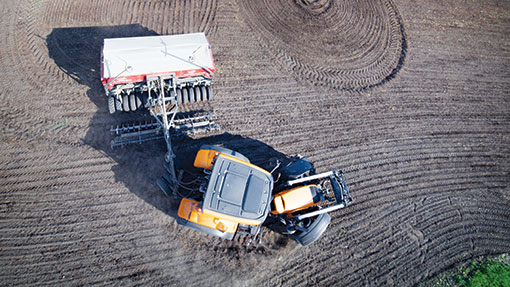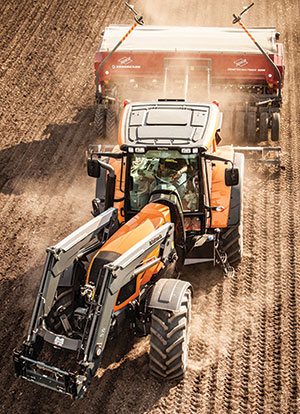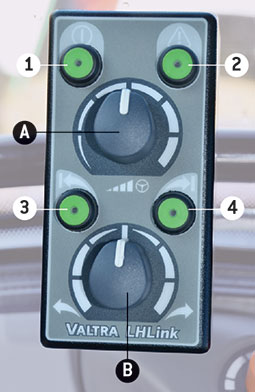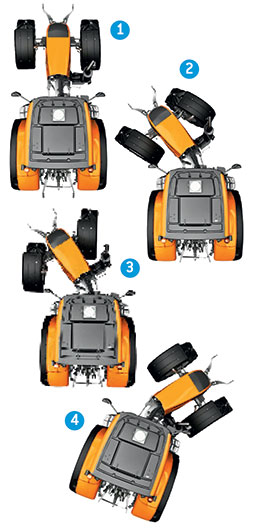Return of Valtra’s bendy tractor

It has been a while since Valtra had its unusual pivot-steer option in the price list, but it is finally set to return. Nick Fone tried out the first prototype machine and found it clever and unnerving in equal measure.
Valtra had an articulated tractor in its armoury for many years. But in 2007 production of its quirky XM model was discontinued, partly because of low sales volumes and partly because the standard M-series had come to the end of its life.
In seven years of production, the bend-in-the-middle model sold in its hundreds, particularly on the Finnish firm’s home turf.
It is estimated there are well over 500 still working across Finland, Sweden and Norway – regions where anything a little bit different tends to go down well.
Here in the UK, the concept had a small but dedicated following, too. Half a dozen XMs made it to British shores and were a favourite with operators looking for a “true-tracking” tug for trailed sprayers.
Its widespread popularity in Scandinavia also came about as a result of the typically cramped livestock buildings in these countries, where its goat-like agility really came into its own. It was a similar story in the forests, too, where carting timber through thinned stands of trees can be a tricky task.
Increasing pressure
After seven years of not having the artic option on its price lists, Valtra dealers that had sold XMs in decent numbers were coming under increasing pressure from owners of ageing machines. They wanted replacements.
Finally, earlier this year, the company relented. It agreed to produce an articulated version of its CVT-equipped N-series tractors, but only as a special order.
The reaction turned out to be something of a shock – heaps of orders have been placed without anyone ever seeing a machine.
The Finnish factory has had to go to some lengths to make it happen. Rather than set up special jigs and chassis-carriers on the production line, it was judged more effective to build each of the new X-Types as a standard tractor and then drive it off the line and into another workshop to make the essential modifications.
Double-jointed
This involves splitting the tractor at the bell-housing and inserting the pivot-point between the engine and the transmission casting with rings of bolts securing big chunks of 20mm plate.

Two double-jointed propshafts run through the centre, one transferring drive from the four-pot Sisu motor to the CVT gearbox, the other sending power to the front axle when required.
Top and bottom pivots lack any form of lateral oscillation, the engineering team preferring instead to keep the tractor chassis rigid and rely on the see-sawing action of the front axle to keep things stable (a lockable, self-levelling beam is an option).
Twin steering rams get their oil-flow from an additional spool slice around at the back.
What is it like to drive?
In everything bar its steering, the X-Type is identical to its conventional cousin. But it is certainly a different looking beast. The sandwiched pivot-point stretches the wheelbase by well over half a metre, giving it something of an awkward, gangly teenager look. It has also piled on the pounds, weighing in some 300kg heavier than the standard N163.
Once in the driving seat, all that extra bulk really becomes apparent – the tip of the bonnet feels miles away and you have really got to start to question all Valtra’s claims about the agility of this artic special.
And the picture does not alter when you fire up the engine. With the pivot set for minimum movement, it is just the front wheels that are responsible for hauling the nose of this stretched-chassis monolith in the desired direction. It is a really numb, cumbersome lump but given that it is generally only in this mode for road work (the pivot locks out above 20kph) it’s no bad thing.
Twiddle the dial to 12 o’clock and things start to get a bit more sensible, with the wheels and pivot-point working in harmony. It might take a bit of getting used to but the bend-in-the-middle mover really begins to show its colours, twisting and turning like a collie on an agility slalom course.
However, with both sets of steering rams working in tandem there is a bit of oil overrun in the system so you do need to pre-empt its serpentine slithering and overcorrecting is a regular issue initially.
Things get strange
Twist the dial right around to the max and things start to get a bit strange. With the pivot set to do all the initial steering, and the wheels taking over when it reaches its max, it can get a bit tail-happy. The back-end tends to cut corners, so giving gateways, stanchions and steelwork a wide berth at first is a good move.
In reality it is like jumping on to a loading shovel or pivot-steer handler after a bit of time away – you soon get a feel for where everything is.
Just for a giggle we decided to swing the seat around to try the steering out in reverse-drive mode (TwinTrac is a £3,524 option). This is where it comes into its own – ideal for buck-raking in tight clamps or ultra-tight headland turns with triple mowers (where it would also do away with missed strips on corners).
Just a shame that the biggest available model is the N163 so those are not likely to be its core tasks.
But taking the X-Type to the max does require some balls. Screw the steering wheel right around to the stops when trundling along at anything up to 20kph and the chassis slews to a 35deg angle, followed by the wheels flipping round to 55deg.
It is a buttock-clenching experience first time around, and with the loader up at any sort of height there is a definite feeling the tractor could flip on its side at any point. Valtra assures us we are miles within the safety zone.
Piece de resistance
With that established, we move on to the new machine’s pièce de résistance – its ability to crab-steer. Previous Valtra artics used just the pivot to steer (although a good number of XM users modified the axle to steer as well).
Now, with both sets of rams able to work simultaneously, the nose of the tractor can be set to point off in one direction while the wheels remain dead ahead.
This means that each of the four tyres runs on fresh ground – a big bonus on softer soils when drilling, cultivating or rolling.
While the theory of this is great, the prototype tractor has a way to go in making this a reality. With chassis and axles set to propel the N-series along and a jaunty angle when you get to the headland, the turnaround procedure is a bit of a muddle.
First you need to set the dial for minimum pivot steer and then swing the wheels back into line with the bonnet. Then you need to hold down the right button to bring the chassis back to dead-centre.
Twist the dial to 12 o’clock, make the turn and then completely reverse the process to get the opposite offset for the return trip down the field. It’s a right palaver.
Valtra says production tractors will have a function where one quick touch of the buttons will bring the chassis into line and a second will slew it out to the opposite angle – a true mirror image.
What the tractor really lacks is any form of wheel-aligning equipment. To make sure all the tyres are pulling in the same direction, it would really benefit from angle sensors that indicate when all four are running in line, whether that’s when crabbing or with the chassis set straight. Currently it is just guesswork. The Finns have promised to look into that.
As the driver swings the steering wheel from left to right, a sensor on the front axle measures wheel angle and, according to how dial A is set, either the wheels will turn or the pivot rams will crank the chassis left or right.
With the dial set at zero, the wheels do all the work, just as they would on a conventional tractor. With it wound right round to the maximum, the pivot steers first and only when it is at its limit do the wheels kick in.

When swinging the steering back to the centre, it is the wheels that lead the way with the pivot coming back in line once they are fully straightened up. Set the dial to its mid-point and both pivot and wheels swing equal amounts.
The controls for the artic-steering set-up on the prototype tractor were based on those used for Valtra’s unique LH-Link front-linkage steering. Production versions will get their own simplified box of tricks, although the principles remain broadly the same.
Button/LED 1 – turns the system on
Button/LED 2 – fault indicator and system override
Dial A – pivot-steering sensitivity – adjusts oil-flow priority between front axle and pivot rams
Button/LED 3 – shunts pivot left to set crab offset
Button/LED 4 – shunts pivot right to set crab offset
Dial B – was fine-tuning for pivot position; will not be on production versions

Sandwiched between the bell-housing and the gearbox, the X-Type’s pivot-point stretches the chassis by 600mm but can slew around to 35deg.
1. In standard mode, the pivot is locked dead-ahead and the front wheels do all the steering
2. Both wheels and the centre-pivot slew in equal amounts
3. In crab-steer, the pivot-point is locked at an angle and the front wheels run offset to the rear wheels
4. Pivot-steering gets oil-flow priority and only once cranked around to 35deg do the wheels start to turn
There is no disguising that the N-series X-Type is a bit of a niche product but the concept certainly has a strong following. Its awesome agility can prove a bit unnerving at the extremities of the steering arc but we are assured it is a safe set-up.
Perhaps counterintuitively, it feels more natural in reverse drive so that probably indicates its niche appeal. That said, there are definite plus points for mainstream loader work – stacking potato boxes and pallets would be a cinch with the pivot providing heaps of side-shift.
And if you have cramped yards, the X-Type will weave its way around much more naturally than a standard tractor.
Valtra N163 standard | Valtra N163 X-Type | |
Power | 163hp max (171hp with pto and transport boost) | |
Engine | 4.9-litre Sisu 4-cyl turbo with AdBlue | |
Transmission | Direct stepless CVT | |
Hydraulics | 115 litres/min | 160 litres/min |
Weight | 5.6t | 5.9t |
Wheelbase | 2.7m | 3.3m |
Min turning circle | 9m | 7m* |
Price | £87,511 | £99,555 |
* Provisional Valtra official figure, although prototype testing suggests this will actually end up closer to 6.3-6.5m | ||

